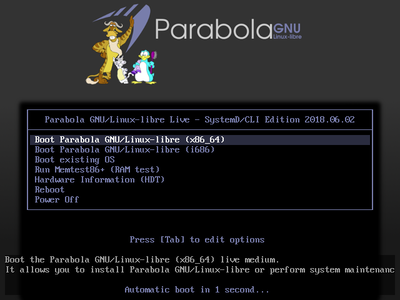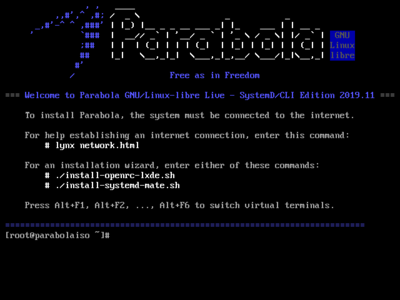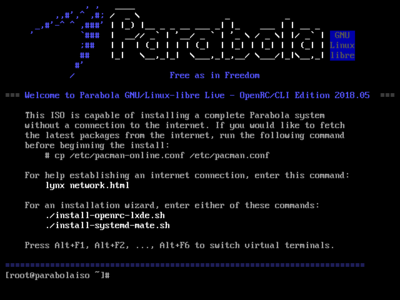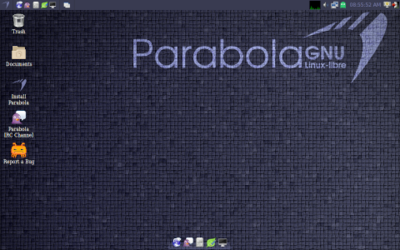Get Parabola
Just as with all software packages in the Parabola repositories, the Parabola GNU/Linux-libre release images are cryptographically signed by a member of the Parabola project. Check-sums are also provided to quickly verify that the downloaded file itself, is not corrupted; but the signature is most significant. Any of these files may be obtained from sources other than directly from the Parabola project or Parabola mirrors. Only a valid signature, confirms that the ISO file was received in the pristine state, as provided by the Parabola project.
The signature can be verified by importing the "Signing Key", noted beside each release image. Verifying signatures is beyond the scope of this article; but the Parabola developers signing keys are published on the Parabola website.
It is strongly recommended that you keep a Parabola LiveISO ready to use at all times. It will save you much time and trouble, if ever the system becomes un-bootable, or otherwise needs repair.
Which one should I choose?
- The init-system and graphical environment of any Parabola LiveISO is completely unrelated to the system that you may choose to install. All Parabola LiveISOs are capable of installing any variant of Parabola system to the target disk, regardless of the init-system or graphical environment. Nothing of the live system can ever be installed onto your computer. For example, any of the SystemD LiveISOs can be used to install an OpenRC system and vice-versa. Likewise, any of the LiveISOs (either CLI or graphical) can be used to install any WM/DE, such as Gnome, KDE, and many others, or none at all.
- The 'Net Install' ISOs are fully usable "live" operating systems for system recovery, or for simply exploring a Parabola system before you install it. Installation from a 'Net Install' ISO requires an active connection to the internet.
- The 'Complete' ISOs are equivalent to their 'Net Install' counterparts, except that they contain everything necessary to install a complete Parabola system, very quickly, with or without a connection to the internet.
- The 'CLI' and 'Talking' ISOs boot into a command-line environment, and do not include an automated installer. Installation is entirely manual, and so requires some basic familiarity with using the command-line.
- The 'LXDE' ISOs boot into the LXDE desktop environment and includes a user-friendly graphical system installer (the Parabola-branded Calamares).
- The Parabola CLI live environment can run in as little as 64 MB RAM, but would be more capable with 128MB RAM.
- The Parabola LXDE live environment can run in as little as 128MB RAM; but would be more capable with 512MB RAM. The graphical installer however, requires 1GB RAM (or swap space) during install. A command-line install wizard is included in the live user's home directory, which can install the same complete desktop or command-line Parabola system, on computers with less memory.
- All of the installers perform a complete clean chroot install, just the same as running the low-level 'pacstrap' program manually. Unlike many distro installers, they will not reuse the frozen "Live" state; but will install a fresh pristine system, regardless of when the LiveISO was published. The ARM tarballs however, are the exception, in that they are not ephemeral "live" environments, and do not include any installer. Those are intended to be cloned bit-for-bit, directly to the target system main storage. This is not the idiomatic "arch-way" of installation; but they are more practical for installing to most hobby/dev boards, which are typically lacking peripherals.
Contents
1 Migrating to Parabola from an existing Pacman-based Distro
If you are currently using another pacman-based distro (e.g. ArchLinux{,32,ARM}, Artix, Manjaro), there is no need to download a Parabola image. Simply follow one of the Migration Guides to set your running system "Free as in Freedom".
2 Release images for x86_64 and i686 architectures
The Parabola ISO images can be burned to a CD/DVD, written to a USB stick, booted directly from GRUB, or booted directly by a virtual machine (the installation guide explains how). If you have an existing Parabola GNU/Linux-libre system, and keep a Parabola LiveISO ready for emergencies, then you should not need to download another LiveISO. An existing Parabola system can be updated simply, at any time, with the pacman -Syu command, or repaired using any Parabola LiveISO.
Be sure to follow the installation guide, if you install manually "The Arch Way".
2.1 Parabola CLI Edition
2.1.1 Parabola SystemD CLI ISO
| Parabola GNU/Linux-libre standard LiveISO images for installation and recovery. (Command-line Edition) |
|
|---|---|
| Architecture | Init System | Desktop | Install | File Size | Packages | Kernel | Download | Checksums |
|---|---|---|---|---|---|---|---|---|
| 32-bit (i686) | SystemD | CLI | Net Install | ~450 MB | i686 | 6.7.4 | Torrent Magnet Web | SHA512SUMS Signature Signing Key |
| 64-bit (x86_64) | SystemD | CLI | Net Install | ~620 MB | x86_64 | 5.17.3 | Torrent Magnet Web | SHA512SUMS Signature Signing Key |
2.2 Parabola Desktop Edition
2.2.1 Parabola SystemD LXDE ISO
| Parabola GNU/Linux-libre standard LiveISO images for installation and recovery. |
|
|---|---|
| Architecture | Init System | Desktop | Install | File Size | Packages | Kernel | Download | Checksums | ||
|---|---|---|---|---|---|---|---|---|---|---|
| None available at this time | ||||||||||
3 Release tarballs for armv7h architecture
The Parabola-ARM release tarballs can be extracted directly to an SD-Card, or to a virtual machine image (see the ARM installation guide). Note that there is currently only a single configuration available, and that it does not include a boot-loader. This may change in the future, if enough demand is expressed for other configurations.
This section also contains raw virtual disk images, which are bootable by Qemu and possibly other virtual machine emulators.
3.1 Parabola CLI Edition
3.1.1 Parabola SystemD CLI Tarball and VM Image
| Parabola GNU/Linux-libre standard tarballs for bootstrapping and VM images for experimenting. (Command-line Edition) |
|
|---|---|
| Architecture | Init System | Desktop | Install | File Size | Packages | Kernel | Download | Checksums |
|---|---|---|---|---|---|---|---|---|
| 32-bit SBCs (armv7h) | SystemD | CLI | VM Image | ~975 MB | armv7h | 5.5.1_gnu | Torrent Magnet Web | SHA512SUMS Signature Signing Key |
| 32-bit SBCs (armv7h) | SystemD | CLI | Tarball | ~560 MB | armv7h | 5.5.1_gnu | Torrent Magnet Web | SHA512SUMS Signature Signing Key |
4 Preview/Beta/Experimental Releases
This section is an exhibit of new features, software, and desktop environments currently in the experimental, testing, or pre-release development stages. Theses are works in progress; but most normal functionality is expected to behave properly.
Please do try them out and report any bugs that you may find to the "Installation Media" bug tracker.
4.1 Various
| Parabola GNU/Linux-libre preview/experimental images. (LXDE Desktop Edition) |
|
|---|---|
| Architecture | Init System | Desktop | Install | File Size | Packages | Kernel | Download | Checksums |
|---|---|---|---|---|---|---|---|---|
| 64-bit (x86_64) | LXDE | Complete | ~1.8 GB | x86_64 | 5.1.6_gnu | Torrent Web | SHA512SUMS Signature Signing Key |
5 HTTP Mirrors
All of the current Parabola release images and software packages are duplicated on each of the official mirror sites listed below. If ever there is a problem with the download sources noted above or the packages manager, you should be able to get what you need manually from one of these mirrors.
| Location | Host |
|---|---|
| California | alomari.ga |
| Denmark | dotsrc.org |
| France | cyberbits.eu |
| Germany | grapentin.org |
| Hungary | quantum-mirror.hu |
| Japan | jing.rocks |
| Massachusettes | fsf.org |
| Netherlands | isacdaavid.info |
| Ontario | uwaterloo.ca |
| Russia | yandex.ru |
| Sweden | infania.net |
| Sweden | umu.se |
| Ukraine | ip-connect.vn.ua |
| Singapore | freedif.org |



